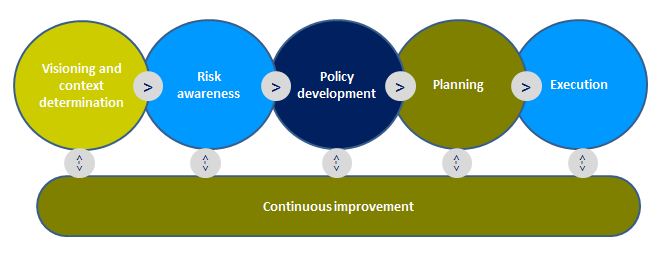| |
Kinds of asset management: a uniform model?
10 August 2012 • Ype Wijnia and John de Croon
asset management strategie, risk management, policy development, planning, program management, manage changes
In the last column, we ended with the triangle of asset management. In the triangle financial asset management, infrastructure asset management and asset management factory form the extremes. That raised the question whether there may be a common core.
Our suspicion is that the core exists, namely by means of the asset management process. Below we have shown the generic process.

This process of course is very similar to the process on our website, but there is some subtle differences. Below we explain the process briefly.
- Vision and context determination: all kinds of asset management know an explicit formulation of the objective of asset management, as well as a vision on role of asset management within the environment and a vision for the development of that environment. Of course there are organisations who only do this implicitly, but in our eyes that is not asset management.
- Risk awareness: the prevailing risks seem to be a strong explanation for the various types of asset management. We also consciously chose to use ‘risk awareness’ and not for ‘risk management’, because on the basis of the risks a management process is designed. These risks are not only controlled in this process
- Policy development: this is the formulation of options for managing the assets and selecting the best option. For financial asset management that is the risk profile of the portfolio, for factories mainly the optimal maintenance strategy and for infrastructure this step mainly includes design guidelines
- Planning: policy is worthless unless it is programmed in an execution plan. The scope is different for all kinds, but the process is applicable for all kinds of asset management
- Execution: policy is worthless without a plan and a plan is worthless without executing it. Financial asset managers will probably execute the plan themselves, maintenance managers manage a team or a contractor and in infrastructures mostly service providers will carry out the plan. There is thus a whole circus of controlling a remotely involved executing party. On our website we call it program management, but that is to ensure that the plans are carried out
- Continuous improvement: ultimately what is feasible or unrealistic affects all previous steps, until the vision.
Perhaps it is possible to translate this process into a kind of menu, which for each process step includes a decision tree which specifies the correct model for the organisation.
Whether that will ever happen is the question. So far, every organisation which applies asset management has implemented something unique. If the result is a menu, it means that we must know exactly in advance what unique configurations belong to which company. But that was not the intention of such a menu. Within industries we actually see more uniformity towards the best practice.
Perhaps that is a better approach: describe the best practice per industry and reflect it on the process model which we presented here. By bundling it some kind of menu is offered for each process step. The only thing is that there is no specific tool to determine the best model for your own organisation. But tell us honestly, would you accept it from a book?
We certainly wish you much wisdom in choosing the right model. Because the period of laying back has ended for us, we are happy to help you by means of our columns.
John de Croon and Ype Wijnia are partner at AssetResolutions BV, a company they co-founded. In turn, they give their vision on an aspect of asset management in a weekly column. The columns are published on the website of AssetResolutions, http://www.assetresolutions.nl/en/column
<< back to overview
|


